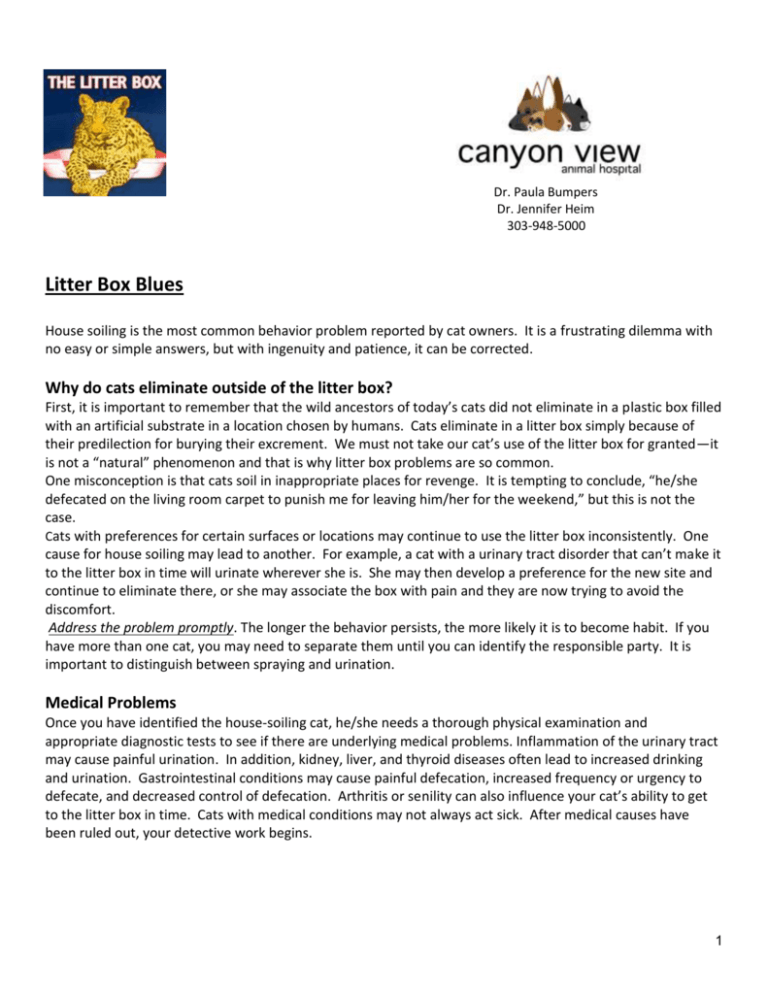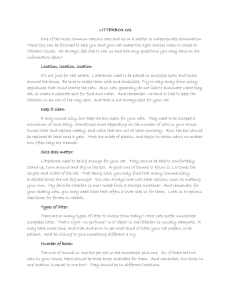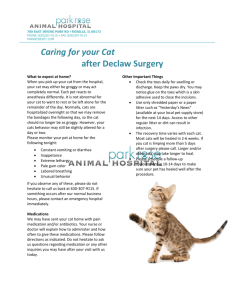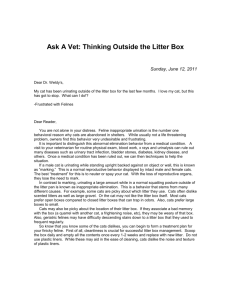Litter Box Blues - Canyon View Animal Hospital
advertisement

Dr. Paula Bumpers Dr. Jennifer Heim 303-948-5000 Litter Box Blues House soiling is the most common behavior problem reported by cat owners. It is a frustrating dilemma with no easy or simple answers, but with ingenuity and patience, it can be corrected. Why do cats eliminate outside of the litter box? First, it is important to remember that the wild ancestors of today’s cats did not eliminate in a plastic box filled with an artificial substrate in a location chosen by humans. Cats eliminate in a litter box simply because of their predilection for burying their excrement. We must not take our cat’s use of the litter box for granted—it is not a “natural” phenomenon and that is why litter box problems are so common. One misconception is that cats soil in inappropriate places for revenge. It is tempting to conclude, “he/she defecated on the living room carpet to punish me for leaving him/her for the weekend,” but this is not the case. Cats with preferences for certain surfaces or locations may continue to use the litter box inconsistently. One cause for house soiling may lead to another. For example, a cat with a urinary tract disorder that can’t make it to the litter box in time will urinate wherever she is. She may then develop a preference for the new site and continue to eliminate there, or she may associate the box with pain and they are now trying to avoid the discomfort. Address the problem promptly. The longer the behavior persists, the more likely it is to become habit. If you have more than one cat, you may need to separate them until you can identify the responsible party. It is important to distinguish between spraying and urination. Medical Problems Once you have identified the house-soiling cat, he/she needs a thorough physical examination and appropriate diagnostic tests to see if there are underlying medical problems. Inflammation of the urinary tract may cause painful urination. In addition, kidney, liver, and thyroid diseases often lead to increased drinking and urination. Gastrointestinal conditions may cause painful defecation, increased frequency or urgency to defecate, and decreased control of defecation. Arthritis or senility can also influence your cat’s ability to get to the litter box in time. Cats with medical conditions may not always act sick. After medical causes have been ruled out, your detective work begins. 1 Litter Box Aversions Behavioral problems are the most common reason for litter box aversion. Cats develop anxiety when there is something about the litter box they find unacceptable. They then seek other areas that meet their needs. It is up to us to determine the cause of their unhappiness and correct the problem. You must ask yourself the following questions: 1. What is wrong with the litter box? 2. Why is the new location more appealing? 3. What changes can I make to attract my cat to the litter box? 4. What can I do to make the new area(s) unappealing? When your cat uses the box, does he/she refuse to bury his/her waste, perch on the edge of the box while eliminating, or go right near the box? This usually indicates that your cat is unhappy with the litter box but is trying to use it despite their distaste. First, we must examine the: 1. Litter box 2. Type of litter 3. Location of the box, or 4. A combination of the three. Something about the litter box bothers your cat. Hygiene: Cats do not like dirty litter boxes. Clean it daily! Some cats refuse to use a box containing any urine or feces whatsoever; meticulous litter box cleanliness is necessary for these individuals. To clean the box, scrub it with dish soap, dry it, and refill with clean litter. You may use dilute bleach solution, but it needs to be rinsed 10 times. Litter should be changed often enough so that it looks and smells dry and clean. The more cats using the box, the more often this will need to be done. Replace old boxes! Alternatively, don’t clean them at all-throw out one dirty litter box (with the used litter) every month or two. If you have multiple boxes, rotate them to avoid too many changes at once. Buy several boxes and keep them on hand. Covered litter box: Most cats do not like covered litter boxes because they hold in and amplify odors and restrict their view. If they are necessary, clean them twice daily. Size, number and shape: Larger cats need bigger boxes. Boxes should be 1 ½ times the length of the cat nose to base of the tail. Kittens and elderly cats may need boxes with low sides. You may need to purchase several types of boxes and several types of litter to determine which combination your cat likes best. Finally, provide as many boxes as there are cats in the house plus one. If you have two cats, there should be three litter boxes. This decreases competition and gives each cat a box of his or her own. Is there one type of surface upon which your cat eliminates? If so, she may have a preference for certain surfaces, and you can modify your litter to match it. If she likes soft surfaces like carpeting, buy a softer, finer litter, and put a carpet remnant in her box. If she has a penchant for smooth, shiny surfaces, consider putting tiles in her box, covered with only a small amount of litter. Over time more litter can be added. 2 Is yours a multi-pet household where another animal terrorizes your cat while she’s in the litter box as she exits? If so, the cat may be afraid to use the box. If you currently use a covered box, replace it with one that gives her a 360-degree view. This will give her more confidence while she’s in the box and make her less prone to ambush. Also, position the box so that she has more than one way out (i.e. don’t have the box surrounded on three sides). Finally, place multiple boxes in multiple locations to give your cat more options. The litter bothers your cat. Your cat may dislike the litter you use, especially if you’ve recently and suddenly changed brands. If you must switch brands, do so gradually, adding more of the new litter to the old with each cleaning. Most cats prefer their litter unscented, and an inch or two deep. The litter is dirty. Cats usually prefer clean litter. The texture of the litter is distasteful. You may need to purchase several types of boxes and several types of litter to determine which combination your cat likes best. Your cat may have a preference for finertextured clumping litter over coarser non-clumping litter or vice versa. There are now products that you can add to the litter that are supposed to attract cats to the litter box, but only use in one box initially to determine if it works for your cat. They can be purchased at most pet stores. The location of the litter box bothers your cat. The box is an unpleasant area. Avoid placing the litter box in a high-traffic, noisy, dark, or dank area. Like us, cats prefer quiet and private areas to do their business. Most cats do not like laundry rooms, especially if the washer/dryer has an alarm. Try a spare bathroom and place the boxes in the tub or shower. Is there a certain location he/she prefers? He/she may have developed a preference for a new area because something bothered her about the old area. Try placing a litter box in her “preferred” location. Once she reliably uses it, gradually move the box just a few inches a day back to the desired location. Stop moving the box if she stops using it; instead simply move it back to the spot where she last reliably used it, and then gradually begin moving it again. This usually works better than most other solutions! Is yours a multi-pet household where another animal terrorizes your cat while she’s in the litter box as she exits? If so, the cat may be afraid to use the box. If you currently use a covered box, replace it with one that gives her a 360-degree view. This will give her more confidence while she’s in the box and make her less prone to ambush. Also, position the box so that she has more than one way out. Finally, place multiple boxes in multiple locations to give your cat more options. Do not place food near the boxes. Cats prefer them in different locations. Urine Spraying Spay or neuter your cat!!!! This is the number one cause of spraying and it is an easy fix. When your cat rubs against your leg with his face, or scratches his scratching post, he is also depositing his scent from the glands in his cheeks and paws. Another equally normal but less pleasant marking behavior is urine spraying–the deposition of small amounts of urine around a given area—which announces a cat’s presence, and establishes or maintains territorial boundaries. 3 Cats usually spray on vertical surfaces, like the backs of chairs, or walls. They don’t squat, but the tail lifts and quivers, and urine is left in several consistent locations. Any cat can spray, but they are more likely to in households with more than three cats. Cats may spray when they perceive a threat to their territory, such as when a new cat enters the home, or when outside cats are nearby. New furniture and carpet smells can prompt spraying as well. Cats may also spray out of frustration resulting from factors such as insufficient playtime, change in diet, etc. How can I stop my cat from spraying? Because spraying is different than other types of house soiling, different tactics are necessary to manage it. Identify the stimuli that cause your cat to spray. If outside cats are responsible, you can discourage your cat from looking outside by closing blinds or shades, or by placing double-sided tape or electronic mats that deliver mild shocks onto your windowsills. Spraying can also result from territorial disputes between cats in the same household. They may need to be separated and reintroduced slowly, using food treats to reward and encourage peaceful behavior. Applying odor neutralizers anywhere your cat has sprayed may prevent him from spraying there again. Another useful commercial product is Feliway, a synthetic pheromone. Many cats will not spray on areas with this scent. Will medications stop my cat from house soiling? Many cats are responsive to anti-anxiety drugs. However, medication is only part of the solution and must be used in conjunction with environmental changes. Any medication can have potential side effects, and not all cats are good candidates. Cats placed on long-term medication must be monitored closely by a veterinarian. What can I use to clean my cat-soiled carpet, couch, and other household items? Clean the surface as much as possible. A cat’s sense of smell is far keener than ours therefore odors must be neutralized, not just deodorized. Avoid cleaners with ammonia–they smell like urine. Most enzyme-based cleaners work well and can be obtained at any pet store. Try the synthetic hormone, Feliway, but read the directions carefully. It works best if used for long periods as directed. What other methods should I consider? Sheets of plastic, newspaper, double-sided tape, sandpaper, electronic mats that deliver harmless, mild shocks, or a carpet runner with the nubs facing up, may all discourage your cat from entering a soil-prone area. Try changing the significance of a soiled area. Cats prefer to eat and eliminate in separate areas, so try placing food bowls and treats in previously soiled areas. Playing with your cat in that space and leaving toys there may also be helpful. Try denying your cat access to a given area by closing doors or by covering the area with furniture or plants. Catch him in the act. A bell on a breakaway collar tells you his whereabouts. If you can catch him within the first seconds of his elimination routine, startle him with a water gun or shake a jar of pennies, so that he associates being startled with those actions. It is important that you startle rather than scare him; fear will only worsen the problem. Moreover, if you catch him after he’s eliminated, your window of opportunity is gone – you must catch him before or during the act. 4 Never hit, kick, or scream at a cat. Not only does this create more anxiety, which may contribute to house soiling behavior, but such tactics provide no link between the “crime” and the punishment. Some owners resort to rubbing their cat’s face in their excrement to “teach the cat a lesson.” This is completely ineffective because even moments later, cats cannot make the connection between the mess and this kind of punishment. Cats do not like citrus smells. Place a citrus-scented air fresher near the area you are protecting. “Ssscat” is a device that you can obtain online (try Ebay) or some pet stores that has a motion detector and emits a strong stream of canned air when movement is detected. This is ideal if your cat is urinating in a remote location. Address possible sources of frustration that may be causing your cat to spray. For example, introduce a new diet gradually, or discontinue it until the spraying is under control. Increasing the amount of playtime for an under-stimulated cat may also help ease frustration. Conclusion A common and frustrating problem, inappropriate elimination can be difficult to control. A full resolution depends on early intervention, followed by detective work to determine the cause of the behavior, and time and effort on your part to solve the problem. Keep in mind that you may never discover exactly what happened to stop your cat from using the litter box. Eventually, through trial and error, you will find the right combination of factors to resolve the problem. In partnership with the Canyon View staff, both cats and the people who love them can live in harmony and good health. Above all—be patient and keep trying different strategies! 5






